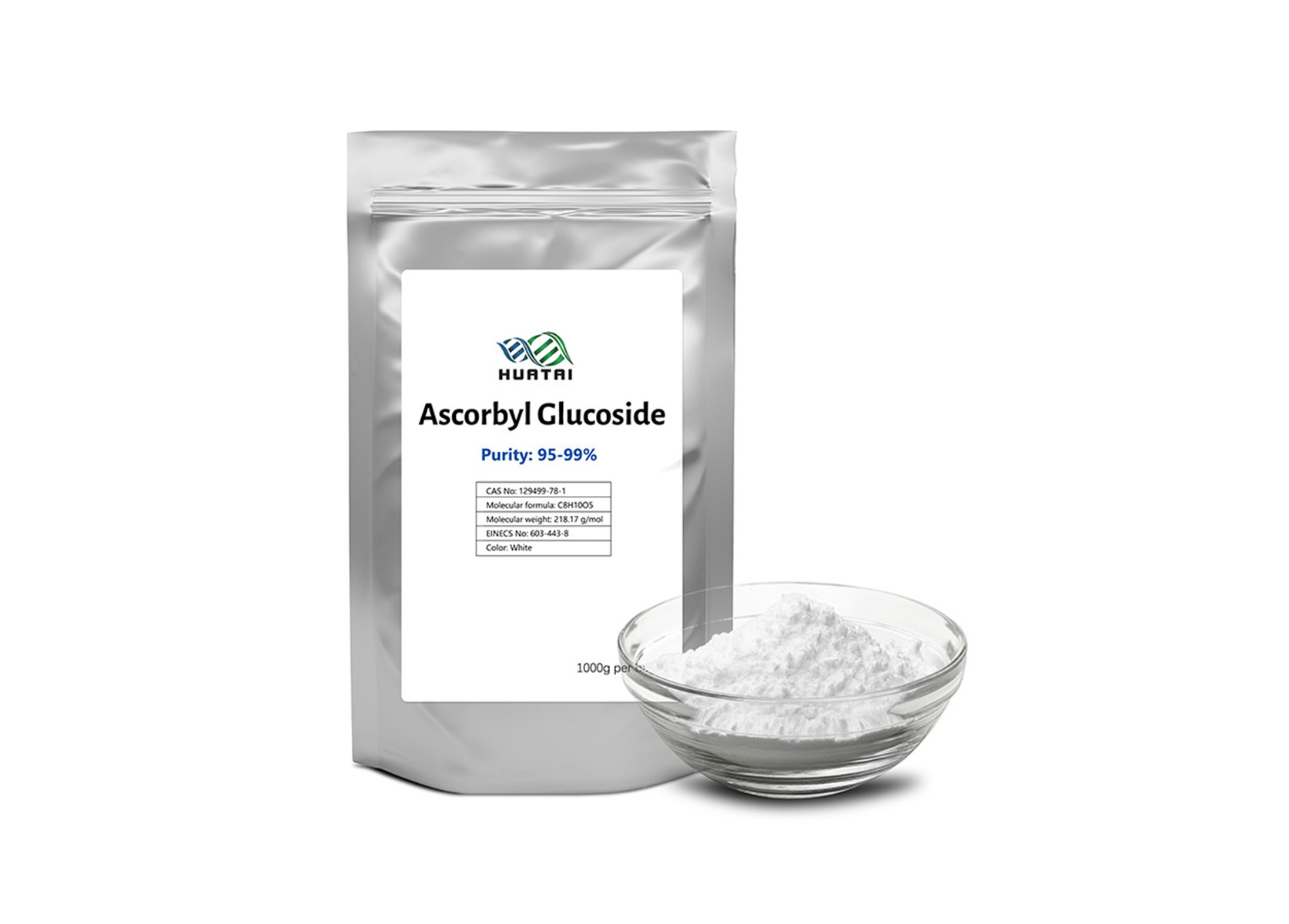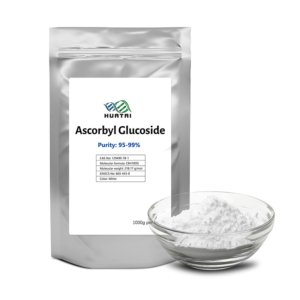
Ascorbyl Glucoside: The Stable Vitamin C Derivative Revolutionizing Skincare
In the competitive world of skincare ingredients, vitamin C derivatives have emerged as powerful contenders, with Ascorbyl Glucoside standing out for its remarkable stability and efficacy. As beauty enthusiasts and dermatologists search for effective yet gentle solutions, this unique compound has gained significant attention for delivering the benefits of vitamin C without its notorious drawbacks.
Introduction: Why Vitamin C Derivatives Matter
Vitamin C’s reputation in skincare is well-established—it neutralizes free radicals, supports collagen synthesis, brightens the complexion, and helps fade hyperpigmentation. However, pure vitamin C (L-ascorbic acid) presents significant formulation challenges, including rapid oxidation when exposed to air, light, and heat. This instability not only renders products ineffective but can also lead to skin irritation.
These limitations have driven the development of vitamin C derivatives, with Ascorbyl Glucoside emerging as a standout option offering excellent stability, gentleness on sensitive skin, and proven efficacy across multiple skincare concerns.
What is Ascorbyl Glucoside?
Ascorbyl Glucoside is a stable vitamin C derivative formed by combining vitamin C (ascorbic acid) with glucose through glycosylation. This creates a water-soluble compound that remains stable in formulations and penetrates the upper skin layers, where it gradually converts to pure vitamin C.
Chemical Structure and Mechanism
The key to Ascorbyl Glucoside’s effectiveness lies in its structure—a glucose molecule attached to vitamin C at the second position of the ascorbic acid ring, creating a glycosidic bond that protects vitamin C’s vulnerable hydroxyl groups from oxidation.
When applied to skin, it works through a two-step process:
- Penetration: The molecule penetrates the stratum corneum
- Conversion: Skin enzymes (alpha-glucosidases) break the glycosidic bond, releasing active vitamin C where needed
This “controlled release” mechanism delivers steady vitamin C to the skin over time, minimizing irritation while maximizing efficacy.
Relationship to Vitamin C
As a “pro-vitamin,” Ascorbyl Glucoside must convert to active vitamin C within the skin to exert its full effects. While this means it works more gradually than pure L-ascorbic acid, it offers significant advantages:
- More sustained effects over time
- Substantially reduced irritation risk
- Stability in formulations until application
This makes Ascorbyl Glucoside particularly valuable in daily-use products where consistent, gentle action is preferable to intense but potentially irritating treatments.
Key Skincare Benefits
Антиоксидантная защита
Like pure vitamin C, Ascorbyl Glucoside functions as a powerful antioxidant, neutralizing damaging free radicals from UV radiation and pollution. Research published in the Journal of Cosmetic Dermatology demonstrates its effectiveness in scavenging reactive oxygen species and protecting against oxidative stress—crucial for preventing premature aging in urban environments.
Brightening and Hyperpigmentation Reduction
One of Ascorbyl Glucoside’s most sought-after benefits is its ability to brighten skin and address hyperpigmentation through:
- Tyrosinase Inhibition: It inhibits the key enzyme in melanin production
- Melanin Dispersion: It helps break up existing melanin clusters
- Противовоспалительное действие: It reduces inflammation that can trigger hyperpigmentation
Clinical studies have shown that formulations containing 2% Ascorbyl Glucoside significantly reduced sunspots and overall skin discoloration after 8 weeks of regular use.
Collagen Synthesis Support
After converting to vitamin C in the skin, Ascorbyl Glucoside supports collagen production by:
- Serving as a cofactor for enzymes that stabilize collagen molecules
- Stimulating collagen gene expression in fibroblasts
- Regulating collagen quality
Research published in Nutrients demonstrated that Ascorbyl Glucoside increased collagen production in human dermal fibroblasts, with effects that were more gradual but longer-lasting than pure vitamin C—suggesting benefits for long-term use.
Even Skin Tone and Texture
Beyond addressing hyperpigmentation, Ascorbyl Glucoside improves overall skin tone and texture by:
- Promoting cell turnover to shed dull surface cells
- Calming inflammation that causes redness
- Supporting optimal hydration for smoother texture
Users typically report noticeably smoother, more refined skin after 4-6 weeks of consistent application.
Enhanced Photoprotection
While not a sunscreen replacement, Ascorbyl Glucoside enhances skin’s defense against UV damage when used as part of a comprehensive sun protection strategy. Research from the Journal of Investigative Dermatology shows that vitamin C derivatives can supplement photoprotection by neutralizing UV-generated free radicals, offering complementary protection when used alongside traditional sunscreens.
Comparison with Other Vitamin C Forms
L-Ascorbic Acid (Pure Vitamin C)
- Advantages of L-AA: Most potent, immediate bioavailability, extensively researched
- Limitations of L-AA: Highly unstable, requires low pH (potentially irritating), short shelf life
- When to Choose Ascorbyl Glucoside: For daily use, sensitive skin, when stability matters
Magnesium Ascorbyl Phosphate (MAP)
- Both are water-soluble and stable
- MAP works best at neutral pH; Ascorbyl Glucoside tolerates wider pH ranges
- Ascorbyl Glucoside shows superior penetration and brightening effects
- MAP particularly excels in hydration benefits
Sodium Ascorbyl Phosphate (SAP)
- Both offer excellent stability in water-based formulations
- SAP has notable anti-acne properties
- Ascorbyl Glucoside generally performs better for hyperpigmentation
- SAP typically costs less, making it common in budget-friendly products
Tetrahexyldecyl Ascorbate (THDA)
- THDA is oil-soluble; Ascorbyl Glucoside is water-soluble
- THDA potentially penetrates deeper due to its lipophilic nature
- Ascorbyl Glucoside works better in lightweight, water-based formulations
- THDA suits very dry skin; Ascorbyl Glucoside suits all skin types
Stability and Formulation Advantages
The exceptional stability of Ascorbyl Glucoside represents one of its most significant benefits in skincare formulations:
pH Flexibility
Unlike L-ascorbic acid, which requires a pH below 3.5 to remain stable (often causing irritation), Ascorbyl Glucoside remains stable across a much wider pH range (approximately 5.0-7.0). This allows for products that are both effective and gentle, making it particularly suitable for sensitive skin that cannot tolerate traditional vitamin C serums.
Environmental Resistance
Ascorbyl Glucoside demonstrates remarkable resistance to factors that typically degrade vitamin C:
- Light Stability: Resists degradation from light exposure
- Heat Tolerance: Maintains integrity at higher temperatures
- Oxygen Resistance: The glycosidic bond prevents oxidation
Stability studies show that Ascorbyl Glucoside retains over 95% of its activity after 6 months at room temperature in water-based formulas, while L-ascorbic acid loses more than half its potency under the same conditions.
Compatibility with Other Actives
Another formulation advantage is Ascorbyl Glucoside’s exceptional compatibility with other skincare ingredients:
- Works synergistically with niacinamide (unlike L-ascorbic acid)
- Can be safely combined with retinoids
- Enhances sunscreen efficacy
- Pairs well with peptides without destabilizing them
This compatibility makes it ideal for comprehensive formulations targeting multiple skin concerns simultaneously.
Benefits for Sensitive Skin
The gentle nature of Ascorbyl Glucoside makes it valuable for sensitive skin types:
- Neutral pH prevents the stinging and redness often experienced with acidic formulations
- Gradual conversion to active vitamin C allows skin to adapt without irritation
- Anti-inflammatory properties can actually help soothe reactive skin
Dermatologists frequently recommend it as an entry point to vitamin C for patients with rosacea, eczema, or generally sensitive skin.
Scientific Research and Safety Profile
Research Findings
Recent studies continue to validate Ascorbyl Glucoside’s efficacy:
- A comparative study in the Journal of Drugs in Dermatology found it particularly effective for hyperpigmentation with minimal irritation potential
- Research from Tokyo Medical and Dental University demonstrated it not only inhibits melanin production but may also protect against UV-induced DNA damage
- Clinical trials show improvements in skin firmness (15.8%) and reduction in fine lines (11.6%) after 12 weeks of twice-daily application
Safety and Expert Perspectives
Ascorbyl Glucoside has an exceptional safety profile:
- Highest safety rating from the Cosmetic Ingredient Review expert panel
- Extremely low rates of sensitization in patch testing
- Considered safe during pregnancy, unlike some other cosmetic actives
Dr. Patricia Wexler, a renowned dermatologist, notes: “Ascorbyl Glucoside has become my go-to recommendation for patients who want vitamin C benefits but have experienced irritation with L-ascorbic acid. It delivers results without compromising the skin barrier.”
The consensus among skin experts is that Ascorbyl Glucoside offers an excellent balance of efficacy and tolerability for a wide range of skin types and concerns.
Conclusion: Ascorbyl Glucoside in Modern Skincare
Ascorbyl Glucoside exemplifies sophisticated cosmetic chemistry—taking vitamin C’s proven benefits and enhancing them through intelligent molecular design. It offers the perfect balance of efficacy, stability, and gentleness, delivering brighter, more even-toned skin without the drawbacks of instability or irritation.
For formulators and manufacturers, it provides unprecedented flexibility, allowing for innovative, multifunctional products that remain stable and deliver reliable results. Its compatibility with other actives enables comprehensive formulations addressing multiple skin concerns simultaneously.
At Shaanxi Huatai Bio-Fine Chemical Co., Ltd, we’ve recognized this ingredient’s exceptional value early, focusing our research on producing pharmaceutical-grade Ascorbyl Glucoside that meets the highest standards of purity and efficacy. Our commitment to advancing cosmetic science drives us to continue exploring new applications for this remarkable vitamin C derivative.
Whether you’re seeking gentler alternatives to traditional vitamin C, creating stable skincare formulations, or recommending solutions for sensitive skin, Ascorbyl Glucoside deserves consideration as a cornerstone ingredient in modern skincare routines.
References
- Telang PS. Vitamin C in dermatology. Indian Dermatology Online Journal. 2013;4(2):143-146. https://www.ncbi.nlm.nih.gov/pmc/articles/PMC3673383/
- Pullar JM, Carr AC, Vissers MCM. The Roles of Vitamin C in Skin Health. Nutrients. 2017;9(8):866. https://www.ncbi.nlm.nih.gov/pmc/articles/PMC5579659/
- Al-Niaimi F, Chiang NYZ. Topical Vitamin C and the Skin: Mechanisms of Action and Clinical Applications. Journal of Clinical and Aesthetic Dermatology. 2017;10(7):14-17. https://www.ncbi.nlm.nih.gov/pmc/articles/PMC5605218/
- Matsuda S, Shibayama H, Hisama M, Ohtsuki M, Iwaki M. Inhibitory effects of a novel ascorbic derivative, disodium isostearyl 2-O-L-ascorbyl phosphate on melanogenesis. Chemical and Pharmaceutical Bulletin. 2008;56(3):292-297. https://pubmed.ncbi.nlm.nih.gov/18310933/
- Pinnell SR. Cutaneous photodamage, oxidative stress, and topical antioxidant protection. Journal of the American Academy of Dermatology. 2003;48(1):1-19. https://pubmed.ncbi.nlm.nih.gov/12522365/
Recommended products
Аскорбил глюкозид
Является производным витамина С, Аскорбил глюкозид обладает высокой стабильностью и биологической активностью. Он может постепенно преобразовываться ферментами в коже в активный витамин С, обеспечивая мягкое, но длительное осветляющее и антиоксидантное действие. Он подходит для широкого спектра рецептур по уходу за кожей, особенно для осветляющих, антивозрастных и отбеливающих средств премиум-класса.





